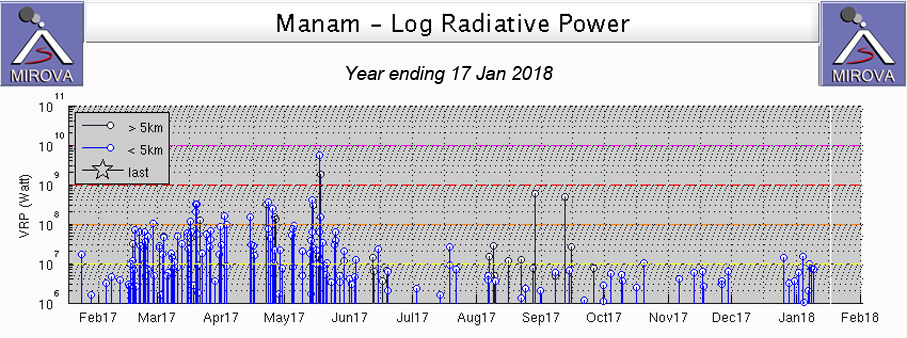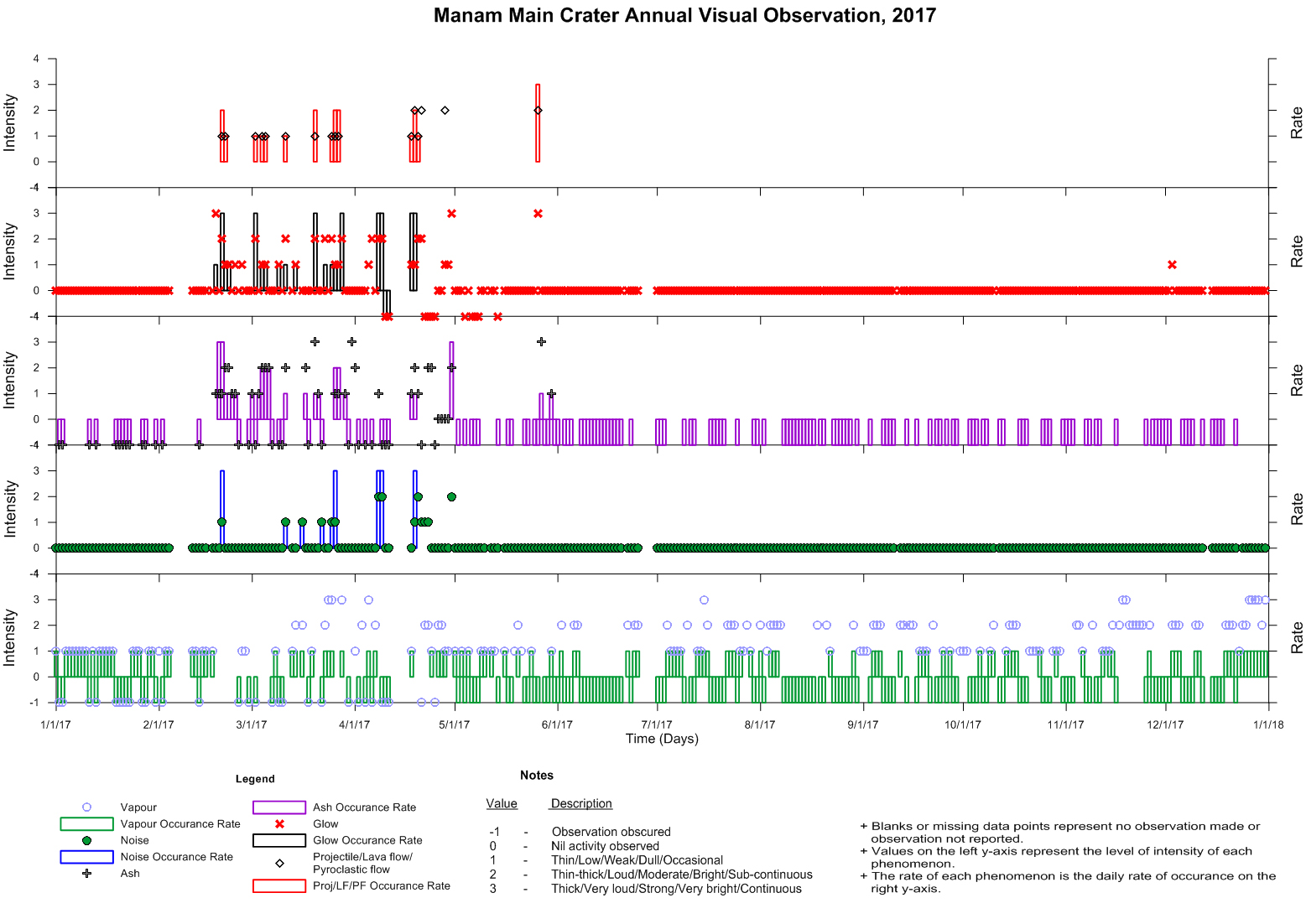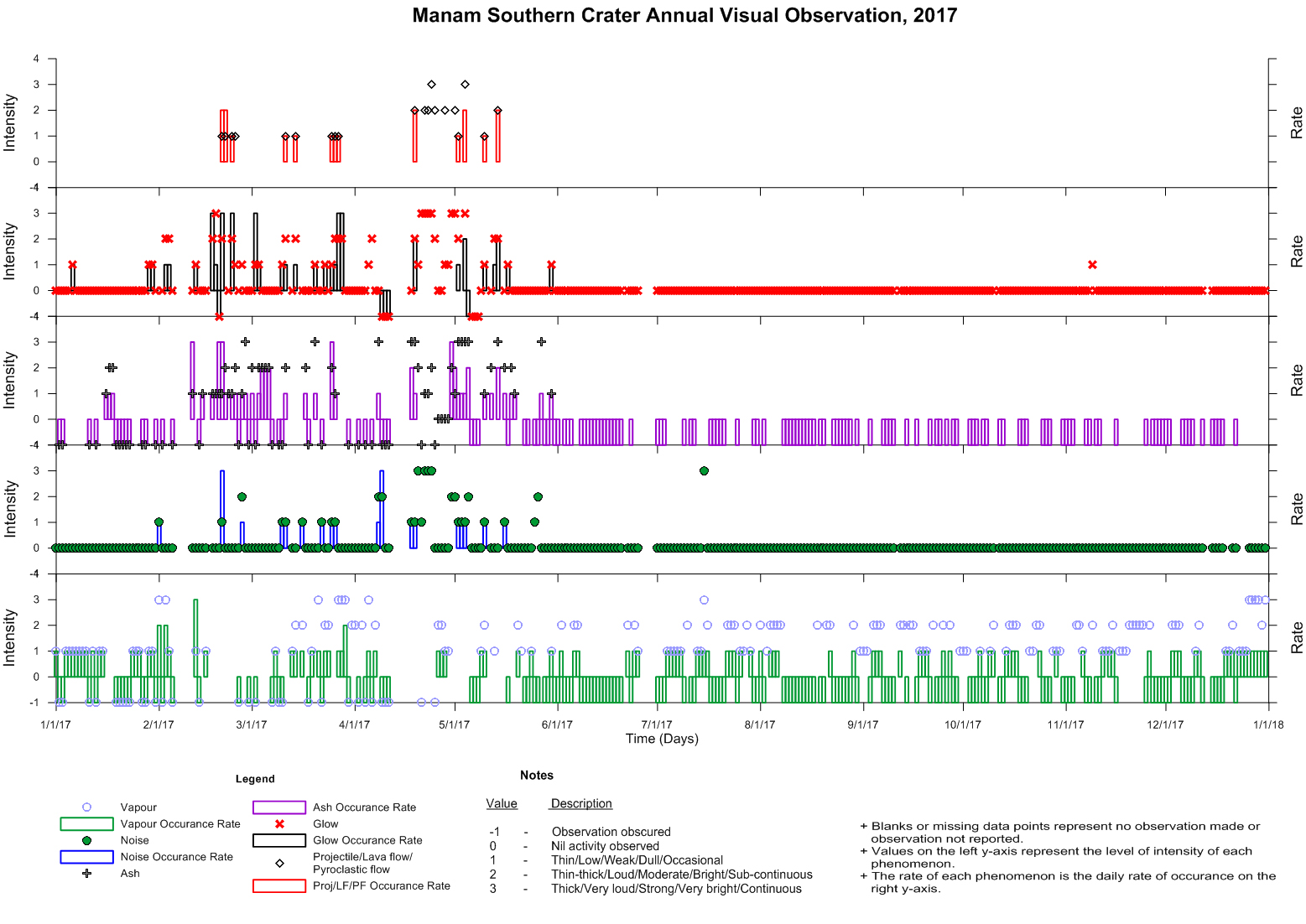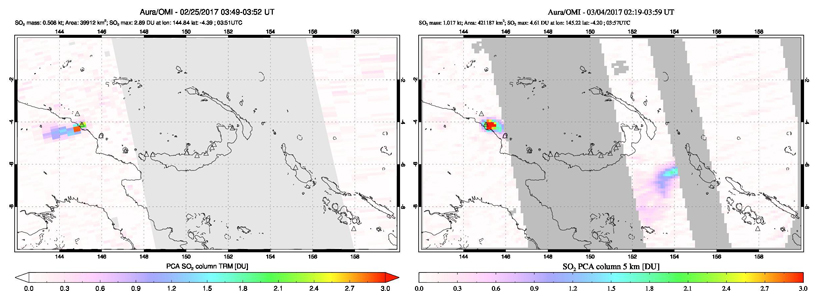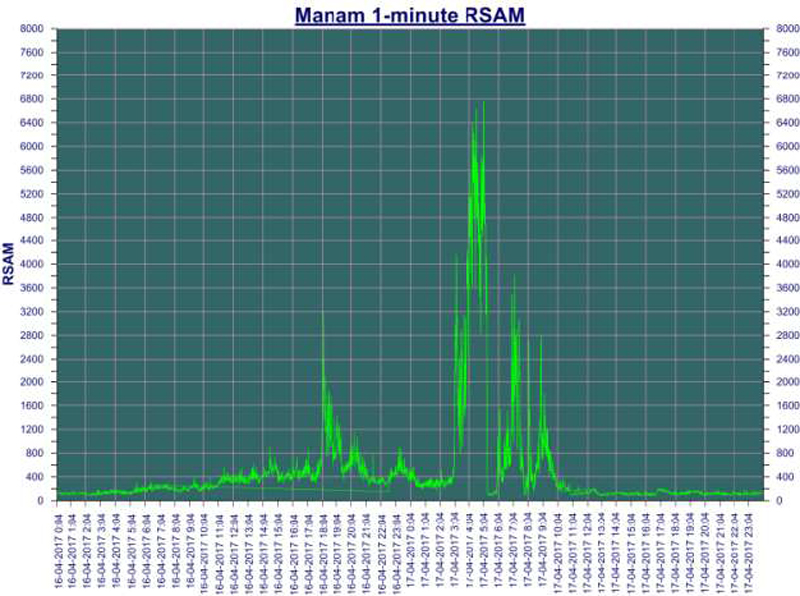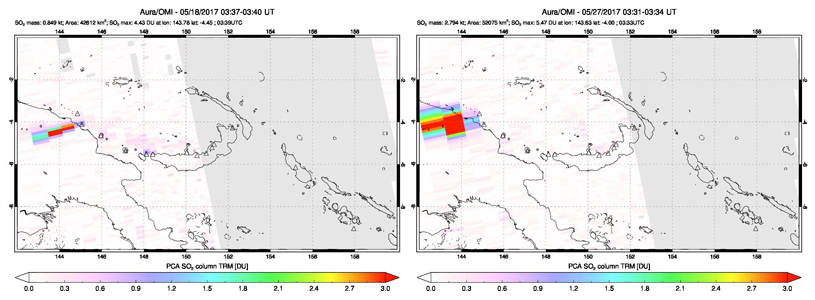Report on Manam (Papua New Guinea) — March 2018
Bulletin of the Global Volcanism Network, vol. 43, no. 3 (March 2018)
Managing Editor: Edward Venzke.
Edited by A. Elizabeth Crafford. Research and preparation by Robert Andrews.
Manam (Papua New Guinea) Ash plumes and Strombolian explosions increase, March-May 2017
Please cite this report as:
Global Volcanism Program, 2018. Report on Manam (Papua New Guinea) (Crafford, A.E., and Venzke, E., eds.). Bulletin of the Global Volcanism Network, 43:3. Smithsonian Institution. https://doi.org/10.5479/si.GVP.BGVN201803-251020
Manam
Papua New Guinea
4.08°S, 145.037°E; summit elev. 1807 m
All times are local (unless otherwise noted)
Manam is a basaltic-andesitic stratovolcano that lies 13 km off the northern coast of mainland Papua New Guinea; it has a 400-year history of recorded evidence for recurring low-level ash plumes and occasional Strombolian emissions, lava flows, pyroclastic avalanches, and large ash plumes. Activity during 2016 included only two episodes of ash emissions, during early March and mid-July, but persistent thermal activity (strongest between March and July 2016) was intermittent throughout the year (BGVN 42:03). Activity from January 2017-January 2018, discussed below, included increased Strombolian activity, lava flows, and ash emissions during February-May 2017 that led to evacuations and concern for local residents. Information about Manam is primarily provided by Papua New Guinea's Rabaul Volcano Observatory (RVO), part of the Department of Mineral Policy and Geohazards Management (DMPGM). This information is supplemented with aviation alerts from the Darwin Volcanic Ash Advisory Center (VAAC). MODIS thermal anomaly satellite data is recorded by the University of Hawai'i's MODVOLC thermal alert recording system, and the Italian MIROVA project; sulfur dioxide monitoring is done by instruments on satellites managed by NASA's Goddard Space Flight Center.
Summary of 2017 activity. A strong surge in thermal activity beginning in mid-February 2017 lasted through mid-June. Low levels of intermittent activity continued for the rest of 2017, with a short-lived increase during late December 2017 and early January 2018 (figure 35). Strong multi-pixel daily MODVOLC thermal alerts began on 17 February and continued through 29 May 2017. Plumes of SO2 were detected with satellite instruments in late February, early March, and during the second half of May.
The first report of ash emissions in 2017 was on 2 March. Activity increased in late March, and again during the second half of April. Most of the many ash plume events that took place during May rose to 2-5 km altitude, but on 4 and 26 May they rose to over 12 km altitude. Ash plumes were noted on only two days during June, and none during July. Minor low-level ash emissions resumed in early and mid-August. The final VAAC report of 2017 was issued on 2 September.
RVO reported incandescent activity, Strombolian explosions, lava and pyroclastic flows, and ash emissions during February-May 2017 from both the Main and Southern craters (figures 36 and 37), and steam-and-gas emissions throughout the year. Activity during late February to mid-April occurred at both craters; most of the activity during late April and May came from Southern Crater. The events of mid-May caused ashfall across the island. Lava flows and pyroclastic flows in mid-April and mid-May led to evacuations from several villages. Incandescence was observed once from Southern Crater in November and once from Main Crater in December.
Activity during February-March 2017. After a break during much of December 2016, low-to-moderate pulses of thermal anomalies were recorded briefly by the MIROVA project early in January 2017 (BGVN 42:03, figure 34). Activity increased again in mid-February with stronger MIROVA anomalies and multi-pixel MODVOLC thermal alerts. Sulfur dioxide plumes were released on 25 February and 4 March 2017 (figure 38).
MODVOLC thermal alerts were issued on 13 days during March, many days had 3-6 alerts. The Darwin VAAC issued the first Volcanic Ash Advisory of 2017 on 2 March based on a pilot report of ash extending N of the volcano at 3 km altitude. The next report, on 20 March, indicated an ash plume visible in satellite imagery moving NE at 2.4 km altitude. It extended 80 km E of the summit the following day. Mostly-steam emissions with minor ash content were reported on 23 March, extending 75 km SE at the same altitude.
Activity during April 2017. Intense multi-pixel MODVOLC thermal alerts continued into April 2017; days with multiple alerts included 2, 14, 22-23, and 25-26 April. RVO released a Volcano Information Bulletin on 16 April 2017 noting a sudden increase in RSAM values beginning on 15 April, and indicating that a small-to-moderate eruption was ongoing from Main Crater. Incandescence was visible during most nights of April from both Main and Southern craters. RSAM values increased by two orders of magnitude during 16-17 April (figure 39). During that night, a brief report from Dugulava village on the SE side of the island indicated that large incandescent lava fragments were falling into valleys to the N and SW, accompanied by loud explosions. Strombolian activity at Southern Crater increased on 18 April, and was accompanied by emissions of dark ash plumes that rose a few hundred meters above the crater and drifted NW. Two small pyroclastic flows were channeled into valleys on the SE and SW flanks, and terminated at about 1,000 m elevation. Strombolian activity subsided by late afternoon, but weak gray ash emissions continued. At Main Crater, white-gray ash plumes continued with bursts of incandescence at about 5-minute intervals.
RVO reported that activity diminished after 18 April but continued at low levels through 21 April; explosions were still heard from both Main and Southern Craters. Both craters were incandescent, but only Southern Crater ejected incandescent tephra, which became briefly intense during the morning of 20 April. Pale gray-to-brown plumes containing minor amounts of ash rose from both craters and drifted SE. RSAM values began to rise again on 22 April, and Strombolian activity continued during 22-24 April (figure 40). According to a news article from 25 April (The National) the Alert Level was raised to Stage 3, and an official on the island noted that evacuations of women and children had begun to Bogia, about 16 km SW on the mainland.
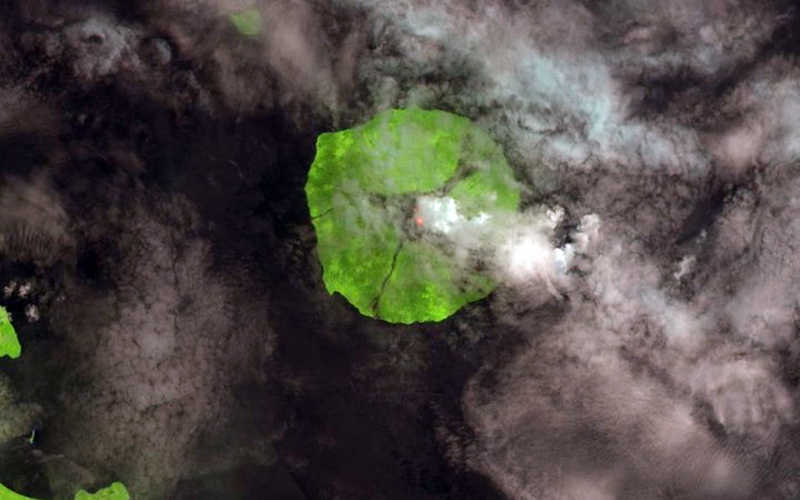 |
Figure 40. An explosion at Manam on 22 April 2017. Incandescence at the summit and steam emissions are visible beneath the meteoric clouds. Photo: USGS/Landsat-8 OLI. Courtesy of Radio New Zealand. |
The Darwin VAAC reported an ash plume at 4.6 km altitude extending about 35 km SE from the summit on 24 April. The next day, an ash plume was observed drifting a similar distance SW at 3 km altitude. The drift direction changed to WSW then W during 26 April, and the plume was last observed about 65 km from the summit. Infrared imagery indicated ongoing activity at the summit.
Strombolian activity and strong, dark-gray ash emissions continued during 24-25 April; activity declined for a few days before the next pulse began during the early morning of 28 April with Strombolian explosions that were heard at the Bogia Government Station. Most of the lava fell back into the crater, but some traveled down the SW and SE valleys, and minor amounts of ash fell on the SE and W parts of the island.
A pulse of moderately-high Strombolian activity occurred from Southern Crater during the early morning of 30 April 2017. The episode lasted about two hours and produced a small pyroclastic flow that was channeled into the SW valley and stopped at about 200 m elevation. Ejected incandescent lava fragments landed mostly within the crater, but some traveled down the SW and SE valleys. Ash and scoria up to 40 mm in diameter fell on the E side of the island in Abaria and Boakure.
Activity during May 2017. The strongest thermal activity of the year was recorded during May 2017. MODVOLC thermal alerts were issued on 4, 5, 9, 13, 14, 17, 18, 25, and 29 May, with 21 alerts issued on 18 May and a single alert on 29 May that was the last issued for the year. RVO reported a Strombolian event from Southern Crater, lasting from about 1700 on 4 May to 0700 the following morning. A lava flow descended into the SW valley to 600 m above sea level, and minor amounts of ash fell in areas stretching between Warisi to the E, Dugulaba on the S, and Boda and Baliab on the NW parts of the island.
The Darwin VAAC reported an ash plume drifting E at 3 km altitude late on 4 May 2017 (UTC). About an hour later, they reported a much higher altitude ash plume moving S from the summit at 12.5 km altitude, in addition to continuous ash moving E at 3 km altitude. The high-level ash plume dissipated after about five hours, but the lower-level emission continued to be visible in satellite imagery drifting E, then NE at least 25 km from the summit through 7 May, after which activity subsided. RVO reported steam-and-gas emissions from Southern Crater on 13 May. Incandescent lava fragments were ejected during the early morning of 14 May, generating a lava flow that traveled down the SW valley to an elevation of 600-700 m.
The next VAAC report, on 14 May 2017, noted an ash plume drifting NW at 4.6 km altitude 35 km from the summit. Later in the day, they reported another short-lived ash plume that rose to 5.5 km altitude drifting almost 100 km W, and a large hotspot over the summit. The lower-altitude plume lasted for another day before dissipating. RVO reported light gray to dark gray ash plumes during 15-18 May. The Darwin VAAC reported multiple plumes moving W at 2.1-2.4 km altitude on 17 May, and continuous emissions extending WNW on 18 May. RVO reported explosive activity on 18 May; a small lava flow traveled down the SW valley, but not as far as the 13-14 May flow. A weak ash emission, which dissipated after a few hours, was reported on 19 May drifting W at 2.7 km altitude. The Darwin VAAC reported that a substantial ash emission on 26 May 2017 was seen in satellite images drifting 55-75 km W at 12.2 km altitude. A second plume from a continuous lower-level eruption was reported later in the day rising to 4.6 km altitude. Both plumes dissipated by the end of the day. Sulfur dioxide emissions were captured by satellite instruments on 18 and 27 May (figure 41).
Activity during June-December 2017. Activity decreased significantly after May 2017 and was low for the remainder of the year. RVO noted weak-to-moderate steam plumes on the rare clear-weather days during June; there was no observed incandescence, and very low seismicity. The Darwin VAAC reported an ash plume that rose to 5.5 km altitude and drifted W on 6 June. Later in the day the plume extended WNW at about 2.4 km altitude. It was last observed early on 7 June before dissipating. No further ash emissions were noted by the Darwin VAAC or RVO until 5 August 2017 when the Darwin VAAC observed minor ash emissions moving NW at 2.1 km altitude. The emissions were visible that day and the next before dissipating. A new ash emission was reported late on 7 August, drifting W at 1.8 km altitude for about 8 hours before dissipating early the next day. Another minor plume on 12 August briefly extended 35 km NW at 2.1 km altitude. During 21-22 August, a similar plume was seen at the same altitude. A minor ash emission on 1 September, which also rose to 2.1 km altitude, was only visible for a few hours before dissipating, and was the last emission reported in 2017.
RVO noted incandescence at Southern Crater once in early November, and once at Main Crater in early December. The MIROVA data showed a cluster of thermal anomalies during late December2017 and early January 2018 (figure 35) suggesting a renewed pulse of thermal activity during that time.
Geological Summary. The 10-km-wide island of Manam, lying 13 km off the northern coast of mainland Papua New Guinea, is one of the country's most active volcanoes. Four large radial valleys extend from the unvegetated summit of the conical basaltic-andesitic stratovolcano to its lower flanks. These valleys channel lava flows and pyroclastic avalanches that have sometimes reached the coast. Five small satellitic centers are located near the island's shoreline on the northern, southern, and western sides. Two summit craters are present; both are active, although most observed eruptions have originated from the southern crater, concentrating eruptive products during much of the past century into the SE valley. Frequent eruptions, typically of mild-to-moderate scale, have been recorded since 1616. Occasional larger eruptions have produced pyroclastic flows and lava flows that reached flat-lying coastal areas and entered the sea, sometimes impacting populated areas.
Information Contacts: Rabaul Volcano Observatory (RVO), Geohazards Management Division, Department of Mineral Policy and Geohazards Management (DMPGM), PO Box 3386, Kokopo, East New Britain Province, Papua New Guinea; Darwin Volcanic Ash Advisory Centre (VAAC), Bureau of Meteorology, Northern Territory Regional Office, PO Box 40050, Casuarina, NT 0811, Australia (URL: http://www.bom.gov.au/info/vaac/); MIROVA (Middle InfraRed Observation of Volcanic Activity), a collaborative project between the Universities of Turin and Florence (Italy) supported by the Centre for Volcanic Risk of the Italian Civil Protection Department (URL: http://www.mirovaweb.it/); Hawai'i Institute of Geophysics and Planetology (HIGP) - MODVOLC Thermal Alerts System, School of Ocean and Earth Science and Technology (SOEST), Univ. of Hawai'i, 2525 Correa Road, Honolulu, HI 96822, USA (URL: http://modis.higp.hawaii.edu/); NASA Goddard Space Flight Center (NASA/GSFC), Global Sulfur Dioxide Monitoring Page, Atmospheric Chemistry and Dynamics Laboratory, 8800 Greenbelt Road, Goddard, Maryland, USA (URL: https://so2.gsfc.nasa.gov/); Radio New Zealand (URL: http://www.radionz.co.nz); The National (URL: http://www.thenational.com.pg).


